Java中的反射是什么?
Java反射是在运行时分析和修改类的所有功能的过程。Java中的反射API用于在运行时操作类及其成员,包括字段、方法、构造函数等。
私有成员和方法的反射也是Java类的一个优点。
这个java.lang.reflect包提供了许多类来实现反射java.方法的java.lang.Class类用于收集特定类的完整元数据。
java.lang.reflect包中的类
下面是中各种Java类的列表java.lang.package包实现反射:
- 字段 Field:此类用于收集声明性信息,如数据类型、访问修饰符、变量的名称和值。
- 方法 Method:一个声明性类型的方法,比如返回一个声明性的方法,类型是一个获取信息的方法。
- 构造函数 Constructor:此类用于收集声明性信息,如访问修饰符、构造函数的名称和参数类型。
- 修饰符 Modifier:此类用于收集有关特定访问修饰符的信息。
java.lang.Class中使用的方法
- Public String getName():返回类的名称。
- public Class getSuperclass():返回超级类引用
- Public Class[]getInterfaces():返回由指定类实现的接口数组
- getModifiers()中的Public:返回一个整数值,表示指定类的修饰符,该修饰符需要作为参数传递给“
Public static String toString(int i)”方法,该方法返回给定类的访问说明符。
如何获取有关一个类的完整信息
要获取有关类的变量、方法和构造函数的信息,我们需要创建该类的对象。

public class Guru99ClassObjectCreation {
public static void main (String[] args) throws ClassNotFoundException {
//1 - By using Class.forname() method
Class c1 = Class.forName("Guru99ClassObjectCreation");
//2- By using getClass() method
Guru99ClassObjectCreation guru99Obj = new Guru99ClassObjectCreation();
Class c2 = guru99Obj.getClass();
//3- By using .class
Class c3= Guru99ClassObjectCreation.class;
}
}以下示例显示了创建类“class”的对象的不同方法:
如何获取类的元数据
下面的示例演示如何获取元数据,例如:类名、超级类名、实现的接口和类的访问修饰符。
我们将得到名为Guru99的下面类的元数据基类:

import java.io.Serializable;
public abstract class Guru99Base implements Serializable,Cloneable {
}- 类的名称是:
Guru99Base - 它的访问修饰符是:
public和abstract - 它实现了接口:可序列化和可克隆
- 由于它没有显式地扩展任何类,因此它的超级类是:
java.lang.Object
得到Guru99的元数据基类然后打印:
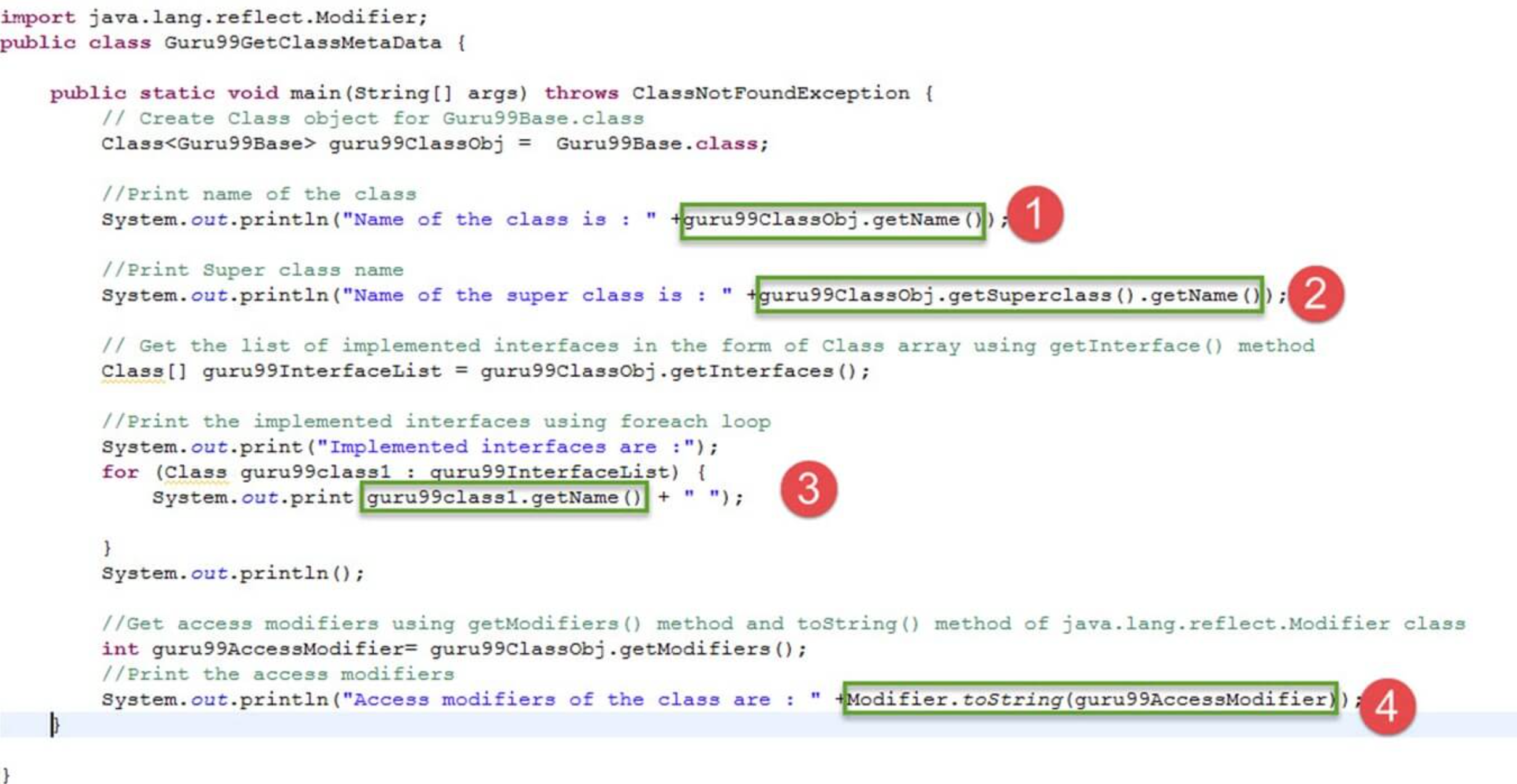
import java.lang.reflect.Modifier;
public class Guru99GetclassMetaData {
public static void main (String [] args) throws ClassNotFoundException {
// Create Class object for Guru99Base.class
Class guru99ClassObj = Guru99Base.class;
// Print name of the class
system.out.println("Name of the class is : " +guru99ClassObj.getName());
// Print Super class name
system.out.println("Name of the super class is : " +guru99ClassObj.getSuperclass().getName());
// Get the list of implemented interfaces in the form of Class array using getInterface() method
class[] guru99InterfaceList = guru99classObj.getInterfaces();
// Print the implemented interfaces using foreach loop
system.out.print("Implemented interfaces are : ");
for (Class guru99class1 : quru99 InterfaceList) {
system.out.print guru99class1.getName() + " ");
}
system.out.println();
//Get access modifiers using get Modifiers() method and toString() method of java.lang.reflect.Modifier class
int guru99AccessModifier= guru99classObj.getModifiers();
// Print the access modifiers
System.Out.println("Access modifiers of the class are : " +Modifier.tostring(guru99AccessModifier));
}
}- 使用
getName方法打印类的名称 - 使用
getSuperClass().getName()方法打印超级类的名称 - 打印实现接口的名称
- 打印类使用的访问修饰符
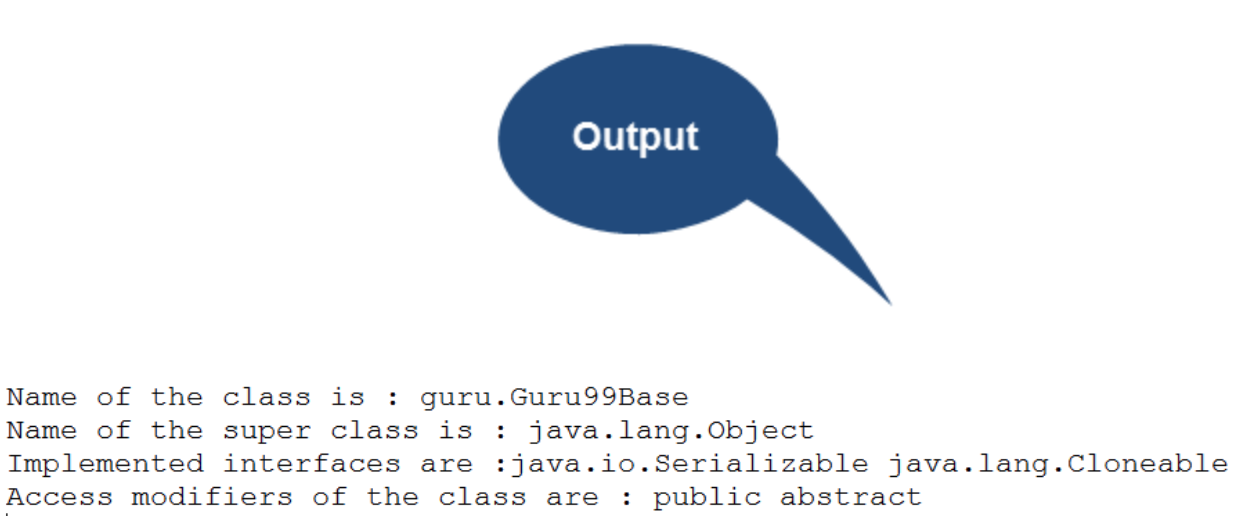
如何获取变量的元数据
以下示例演示如何获取变量的元数据:
在这里,我们正在创建一个名为guru99variableMetata的类
package guru;
public class Guru99VariableMetaData {
public static int guru99IntVar1=1111;
static int guru99IntVar2=2222;
static String guru99StringVar1="guru99.com";
static String guru99StringVar2="Learning Reflection API";
}获取上述类中变量的元数据的步骤:
创建上述类的类对象,即Guru99VariableMetaData.class具体如下:
Guru99VariableMetaData guru99ClassVar = new Guru99VariableMetaData();
Class guru99ClassObjVar = guru99ClassVar.getClass();使用getFields()或getDeclaredFields()方法获取字段数组形式的元数据,如下所示:
Field[] guru99Field1= guru99ClassObjVar .getFields();
Field[] guru99Fiel2= guru99ClassObjVar .getDeclaredFields();getFields() 方法从指定的类及其超类返回公共变量的元数据。
getDeclaredFields() 方法只返回指定类中所有变量的元数据。
- 使用“
public String getName()”方法获取变量的名称。 - 使用“
public Class getType()”方法获取变量的数据类型。 - 使用“
public xxx Get(Field)”方法获取变量的值。
在这里,xxx可以是一个字节,也可以是我们要获取的任何类型值的短字节。
使用getModifier()和修饰符Modifier.toString(int i)方法。
在这里,我们编写一个类来获取类Guru99VariableMetaData中存在的变量的元数据。类:
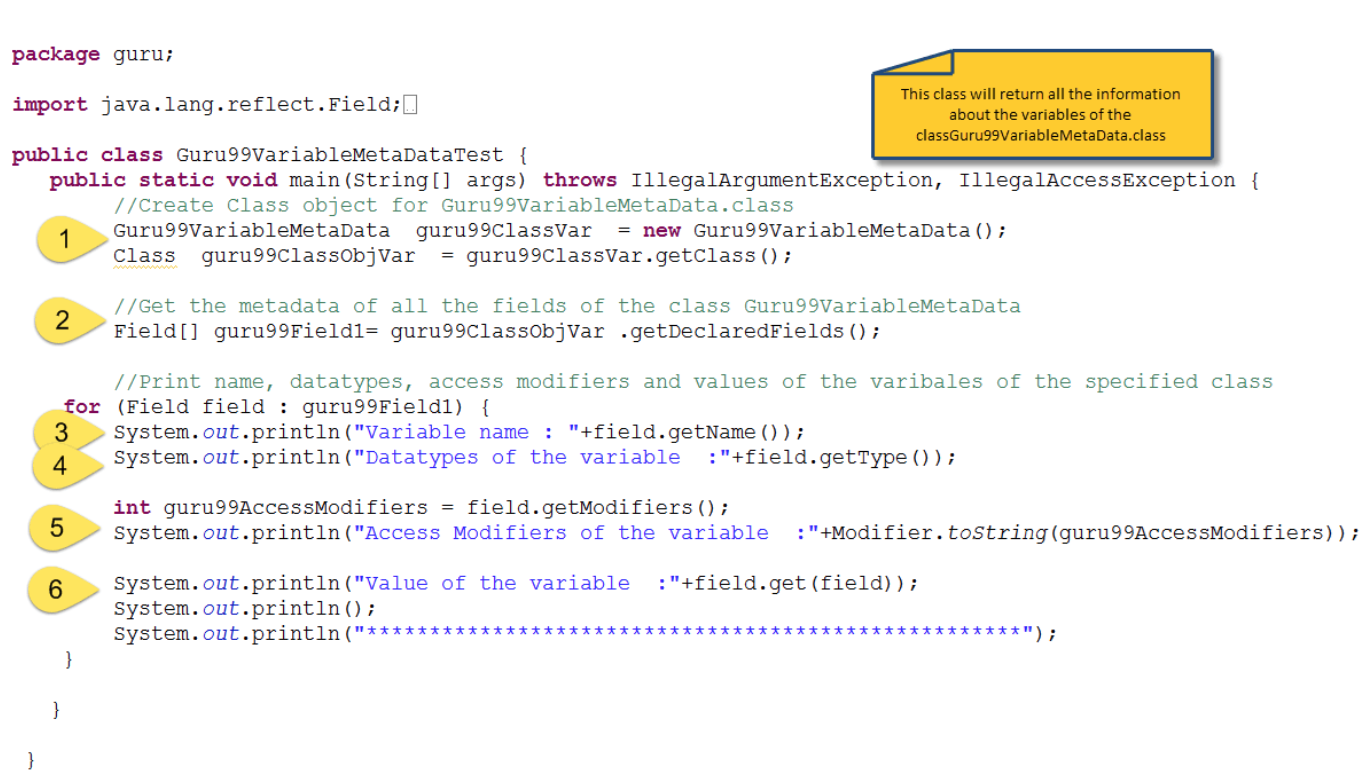
package guru;
import java.lang.reflect.Field;
public class Guru99VariableMetaDataTest {
public static void main(String[] args) throws IllegalArgumentException, IllegalAccessException {
// Create Class object for Guru99VariableMetaData.class
Guru99VariableMetaData guru99ClassVar = new Guru99VariableMetaData();
Class guru99ClassObjVar = guru99ClassVar.getClass();
// Get the metadata of all the fields of the class Guru99VariableMetaData
Field[] guru99Field1= guru99ClassObjVar.getDeclaredFields();
// Print name, datatypes, access modifiers and values of the varibales of the specified class
for(Field field : guru99Field1) {
System.out.println("Variable name : "+field.getName());
System.out.println("Datatypes of the variable :"+field.getType());
int guru99AccessModifiers = field.getModifiers();
System.out.printlln("Access Modifiers of the variable : "+Modifier.toString(guru99AccessModifiers));
System.out.println("Value of the variable : "+field.get(guru99ClassVar));
System.out.println();
system.out.println("* * * * * * * * * * * * * * * * * * * * * * * * * * * * * * * * * * * * *") ;
}
}
}- 为Guru99创建类对象
VariableMetaData.class - 获取字段数组中变量的所有元数据
- 打印了类Guru99中的所有变量名
VariableMetaData.class - 打印了Guru99类中变量的所有数据类型
VariableMetaData.class - 打印了Guru99类中变量的所有访问修饰符
VariableMetaData.class - 打印中所有变量的值打印Guru99类中变量的所有数据类型
VariableMetaData.class
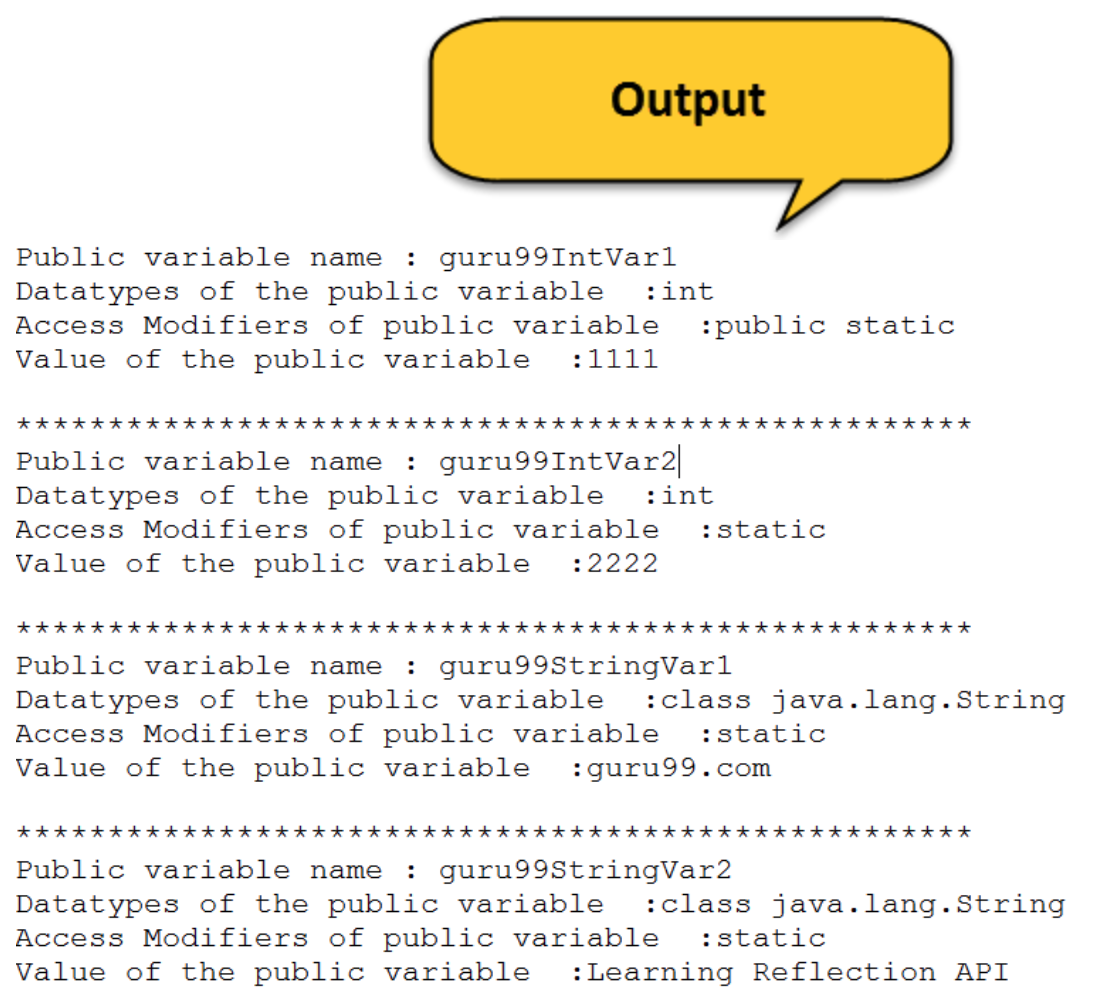
如何获取方法的元数据
以下示例说明如何获取方法的元数据:
在这里,我们用一些方法创建一个名为Guru99MethodMetaData.class的类
package guru;
import java.sql.SQLException;
public class Guru99MethodMetaData {
public void guru99Add(int firstElement, int secondElement , String result)
throws ClassNotFoundException, ClassCastException{
System.out.println("Demo method for Reflextion API");
}
public String guru99Search(String searchString)
throws ArithmeticException, InterruptedException{
System.out.println("Demo method for Reflection API");
return null;
}
public void guru99Delete(String deleteString)
throws SQLException{
System.out.println("Demo method for Reflection API");
}
}获取上述类中方法的元数据的步骤:
创建上述类的类对象,即Guru99MethodMetaData.class具体如下:
Guru99MethodMetaData guru99ClassVar = new Guru99MethodMetaData ();
Class guru99ClassObjVar = guru99ClassVar.getClass();
使用getMethods()和getDeclaredMethods()方法获取方法数组中的方法信息,如下所示:
Method[] guru99 Method 1= guru99ClassObjVar .get Methods();
Method [] guru99 Method 2= guru99ClassObjVar .getDeclared Method s();getMethods()方法从指定的类及其超类返回公共方法的元数据。
getDeclaredMethods()方法只返回指定类中所有方法的元数据。
- 使用
getName()方法获取方法的名称。 - 使用
getReturnType()方法获取方法的返回类型。 - 使用
getModifiers()和Modifiers.toString(int i)方法。 - 使用返回类数组的
getParameterTypes()方法获取方法参数类型。 - 使用返回类数组的
getExceptionTypes()方法获取引发的异常。
这里,我们正在编写一个类来获取Guru99类中存在的方法的元数据MethodMetaData.class:
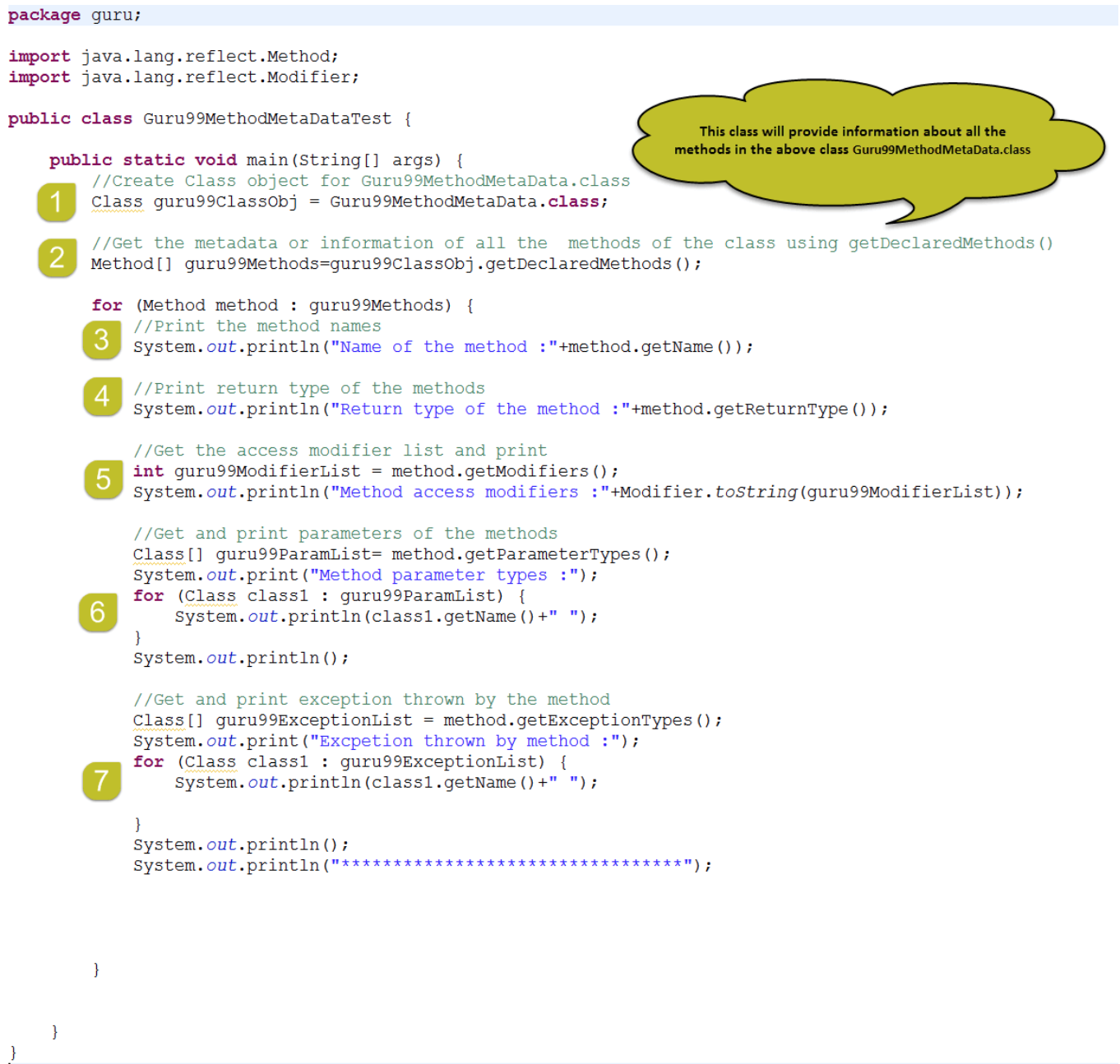
package guru;
import java.lang.reflect.Method;
import java.lang.reflect.Modifier;
public class Guru99MethodMetaDataTest {
public static void main (String[] args) {
// Create Class object for Guru99Method MetaData.class
class guru99ClassObj = Guru99MethodMetaData.class;
// Get the metadata or information of all the methods of the class using getDeclaredMethods()
Method[] guru99Methods=guru99classObj.getDeclaredMethods();
for(Method method : guru99Methods) {
// Print the method names
System.out.println("Name of the method : "+method.getName());
// Print return type of the methods
System.out.println("Return type of the method : "+method.getReturnType());
//Get the access modifier list and print
int guru99ModifierList = method.getModifiers();
System.Out.printlin ("Method access modifiers : "+Modifier.toString(guru99ModifierList));
// Get and print parameters of the methods
Class[] guru99ParamList= method.getParameterTypes();
system.out.print ("Method parameter types : ");
for (Class class1 : guru99ParamList){
System.out.println(class1.getName()+" ");
}
System.out.println();
// Get and print exception thrown by the method
Class[] guru99ExceptionList = method. getExceptionTypes();
system.out.print("Excpetion thrown by method :");
for (Class class1 : guru99ExceptionList) {
System.out.println (class1.getName() +" "):
}
System.Out.println();
system.out.println("* * * * * * * * * * * * * * * * * * * * * * * * * * * * * * * ");
}
}
}- 为Guru99创建类对象
MethodMetaData.class - 获取方法数组中所有方法的所有元数据
- 打印Guru99类中存在的所有方法名称
MethodMetaData.class - Guru99类中方法的打印返回类型
MethodMetaData.class - 打印Guru99类中方法的所有访问修饰符
MethodMetaData.class - Guru99中方法的打印参数类型
MethodMetaData.class - Guru99中的方法抛出打印异常
MethodMetaData.class
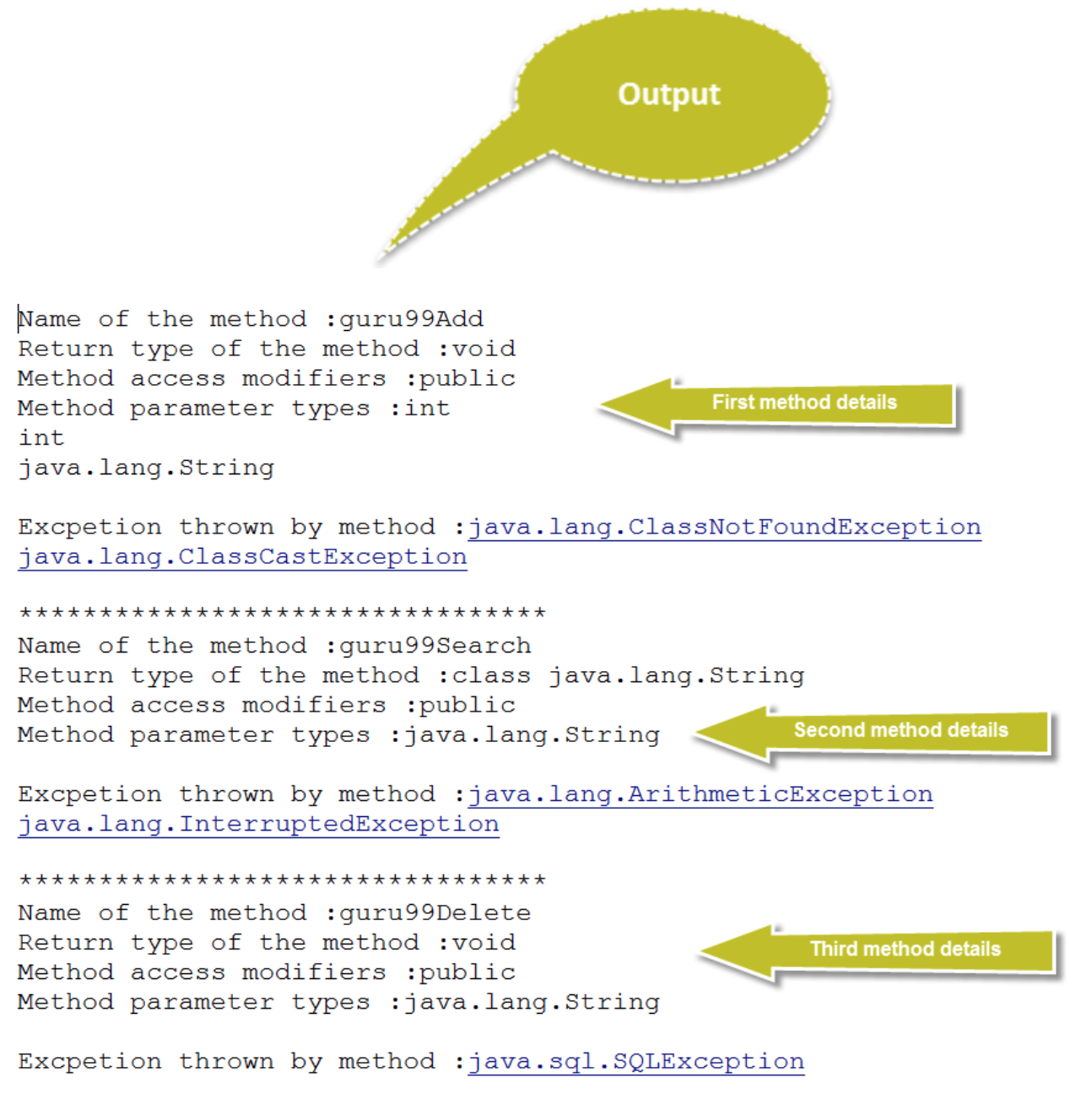
如何获取构造函数的元数据
以下示例说明如何获取构造函数的元数据:
在这里,我们正在创建一个名为Guru99的类构造函数.class使用不同的构造函数:
package guru;
import java.rmi.RemoteException;
import java.sql.SQLException;
public class Guru99Constructor {
public Guru99Constructor(int no) throws ClassCastException ,ArithmeticException{ }
public Guru99Constructor(int no, String name) throws RemoteException ,SQLException{ }
public Guru99Constructor(int no, String name, String address) throws InterruptedException{ }
}这里,我们正在编写一个类来获取类Guru99中的构造函数的元数据构造函数.class:

package guru;
import java.lang.reflect.Constructor;
public class Guru99ConstructorMetaDataTest {
public static void main (String[] args) {
// Create Class object for Guru99Constructor.class
Class guru99Class=Guru99Constructor.class;
// Get all the constructor information in the Constructor array
Constructor[] guru99ConstructorList = guru99Class.getConstructors();
for (Constructor constructor : guru99ConstructorList) {
// Print all name of each constructor
System.out.println("Constrcutor name : "+constructor.getName());
//Get and print access modifiers of each constructor
int guru99Modifiers= constructor.getModifiers();
System.Out.printlin ("Constrctor modifier : "+Modifier.toString(guru99Modifiers));
// Get and print parameter types
Class[] guru99ParamList=constructor.getParameterTypes();
System.out.print ("Constrctor parameter types :");
for (Class class1 : guru99ParamList) {
System.out.println(class1.getName() +" ");
}
System. out.println();
// Get and print exception thrown by constructors
Class[] guru99ExceptionList=constructor.getFxceptionTypes();
System.out.println("Exception thrown by constructors :");
for (Class class1 : guru99ExceptionList) {
System.out.println(class1.getName() +" ");
}
System.out.println();
System.out.println("*******************************************");
}
}
}- 为Guru99创建类对象构造函数.class
- 获取构造函数数组中所有构造函数的所有元数据
- 打印了类Guru99中存在的所有构造函数的名称构造函数.class
- 打印了类Guru99中构造函数的所有访问修饰符构造函数.class
- Guru99中构造函数的打印参数类型构造函数.class
- 打印的异常由Guru99中的构造函数抛出构造函数.class
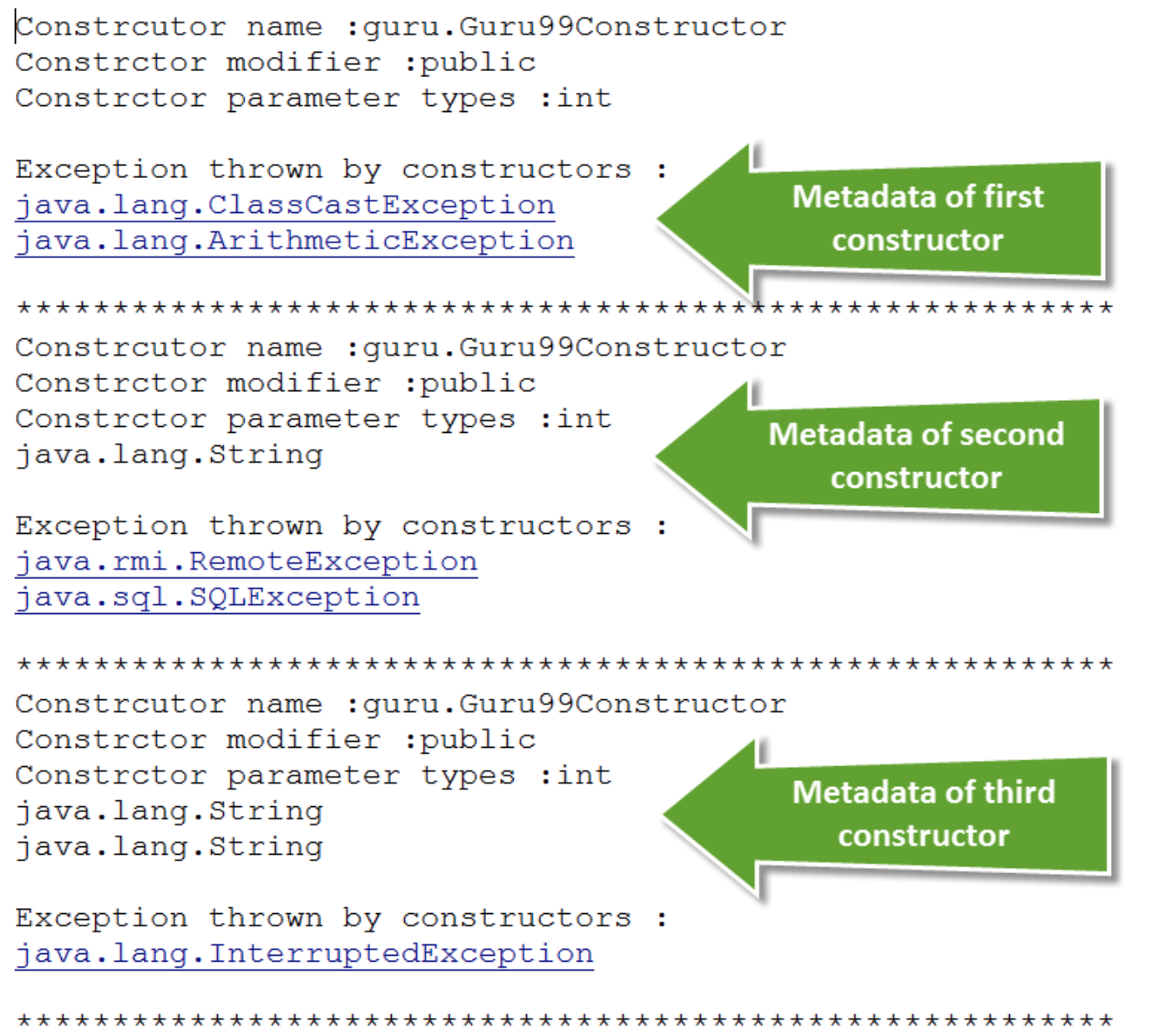
Java反射总结:
- java中的反射编程有助于检索和修改有关类和类成员(如变量、方法、构造函数)的信息。
- Java中的反射API可以使用中的类实现
java.lang.reflect包package和方法java.lang.Class。 - 一些常用的方法
java.lang.Class类包括getName()、getSuperclass()、getInterfaces()、getModifiers()等。 - 一些常用的类
java.lang.reflect包是字段、方法、构造函数、修饰符等。 - 反射API可以访问类的私有方法和变量,这可能是安全威胁。
- 反射API是Java提供的一种强大的功能,但它也会带来一些开销,例如性能降低、安全漏洞和权限问题。因此,反射API应该被视为执行操作的最后手段。
除特别注明外,本站所有文章均为老K的Java博客原创,转载请注明出处来自https://javakk.com/713.html




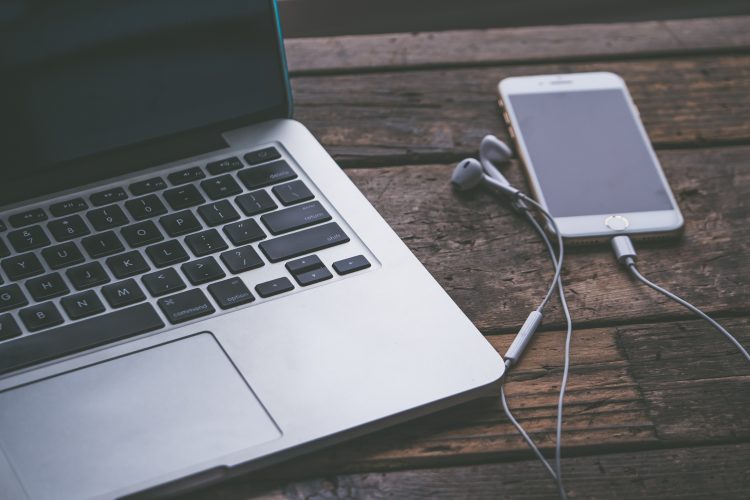 在这个努力程度如此低下的时代,还轮不到比拼天赋。静下心来,just do it
在这个努力程度如此低下的时代,还轮不到比拼天赋。静下心来,just do it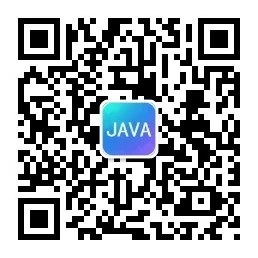

暂无评论